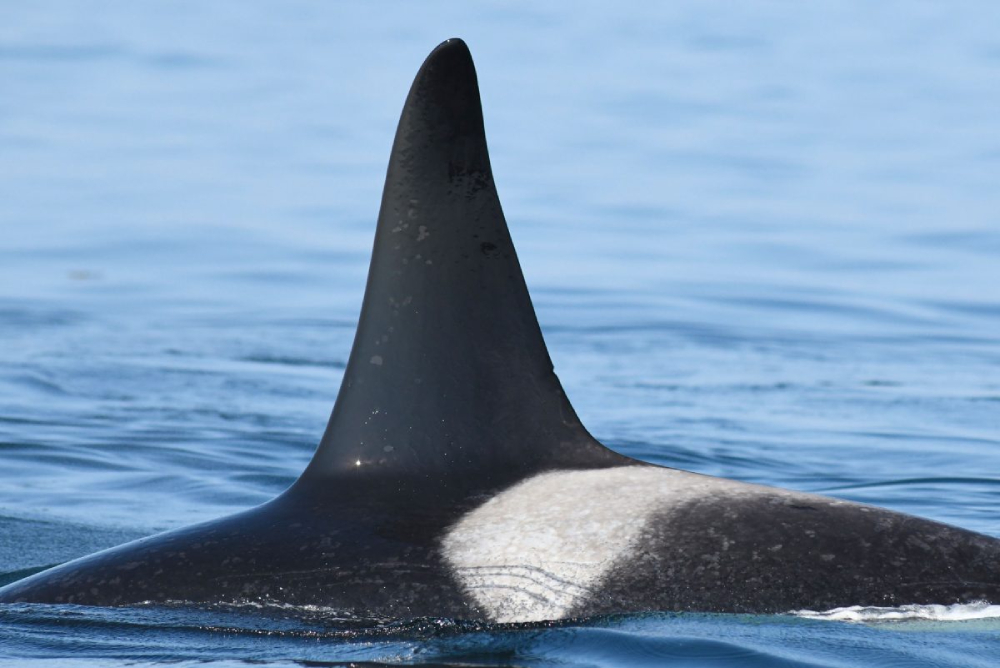When southern resident killer whales off the coast of British Columbia and Washington state surface for breath, they show off pointy dorsal fins and their iconic black-and-white colouration. But a closer inspection can reveal white scars scratched onto their otherwise sleek backs. These scars are from bite marks — “tooth rakes” — inflicted during skirmishes with other killer whales.
In a new study, scientists have shown that by analyzing these scars they can better understand the aggressive behaviour at play beneath the surface. And by examining how the prevalence of scarring has changed over several decades, they can see how killer whales’ aggressive interactions have changed over their lifetimes — and even begin to understand why.
Charli Grimes, a whale researcher at the University of Exeter in England and lead author of the new paper, says southern resident killer whales are “quite placid and quite playful” compared to other groups of killer whales. Scientists have only ever directly seen one case of a southern resident killer whale attacking another killer whale, though as evidenced by the scars, they know that these aggressive interactions must happen readily underwater.
Since sightings of aggressive behaviour are so rare, Grimes and her colleagues used photographs of tooth rakes as an indirect method for studying aggression.
Tooth rakes have been looked at in other cetacean species — most notably bottlenose dolphins — for decades. The new study, however, is one of the few to apply the approach to killer whales, and the first using it to study the southern residents. Because the bite marks heal over time, scientists track when the killer whales are accruing new scars.
Since 1976, scientists with the Center for Whale Research in Washington have been photographing the region’s southern resident killer whales. Using photo analysis software, Grimes and her team quantified the amount of scar tissue borne by 167 different killer whales over a 38-year study period.
They found that young male killer whales have the highest number of fresh scars, a finding that seemed predictable to the team given killer whale social structures.
Southern residents have a matriarchal social structure, says Grimes, and young whales duke it out to establish their spot in the hierarchy and to get first dibs on prey. Young males also spar for females’ attention, she adds.
Because they had such a long photographic record to analyze, the scientists could take the study a step further. By correlating their scar data with records of salmon abundance through time, they found that changes in salmon availability affect the amount of aggression and scarring.

Though Grimes and her colleagues originally assumed that the prevalence of tooth rakes would increase when salmon are scarce, as the cetaceans compete for their favourite food, they actually found the opposite: more salmon meant more scars.
Grimes has a potential explanation for this unexpected finding.
“At times of high salmon availability,” she says, “the social network of southern residents is more interconnected.”
More salmon could lead to bigger aggregations of killer whales, and to more social interactions. Plus, with energy to spare, younger whales may be engaging in rough-and-tumble play, resulting in more scars.
Todd Robeck, a conservation researcher at SeaWorld Parks and Entertainment, has previously studied aggressive behaviour and tooth rakes in killer whales but was not involved in the current study. Robeck’s previous research showed that transient (Bigg’s) and northern resident killer whales in the northeast Pacific have a different pattern of scar acquisition — in those populations, older male killer whales have more fresh scars. This confirms, he says, that the different groups have very different social structures and behaviours.
“The most interesting thing was that the rake marks were increasing with food,” says Robeck. Although surprising, he says the pattern isn’t entirely unheard of, as many primates are also less aggressive when food is scarce.
For future studies, the method of analyzing photographs of tooth rakes could also be applied to other populations of killer whales and to tease out the factors that influence aggression.
Robeck and Grimes agree that behavioural studies such as this one would be bolstered by drone or underwater footage.
By following killer whale behaviour beyond what can be observed from above-water photographs, scientists may soon reveal what aggressive behaviour actually looks like beneath the waves. ![]()
Read more: Science + Tech, Environment
















Tyee Commenting Guidelines
Comments that violate guidelines risk being deleted, and violations may result in a temporary or permanent user ban. Maintain the spirit of good conversation to stay in the discussion.
*Please note The Tyee is not a forum for spreading misinformation about COVID-19, denying its existence or minimizing its risk to public health.
Do:
Do not: